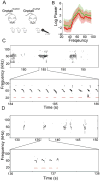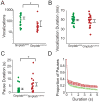A Mutation Associated with Stuttering Alters Mouse Pup Ultrasonic Vocalizations
- PMID: 27151663
- PMCID: PMC5063665
- DOI: 10.1016/j.cub.2016.02.068
A Mutation Associated with Stuttering Alters Mouse Pup Ultrasonic Vocalizations
Abstract
A promising approach to understanding the mechanistic basis of speech is to study disorders that affect speech without compromising other cognitive or motor functions. Stuttering, also known as stammering, has been linked to mutations in the lysosomal enzyme-targeting pathway, but how this remarkably specific speech deficit arises from mutations in a family of general "cellular housekeeping" genes is unknown. To address this question, we asked whether a missense mutation associated with human stuttering causes vocal or other abnormalities in mice. We compared vocalizations from mice engineered to carry a mutation in the Gnptab (N-acetylglucosamine-1-phosphotransferase subunits alpha/beta) gene with wild-type littermates. We found significant differences in the vocalizations of pups with the human Gnptab stuttering mutation compared to littermate controls. Specifically, we found that mice with the mutation emitted fewer vocalizations per unit time and had longer pauses between vocalizations and that the entropy of the temporal sequence was significantly reduced. Furthermore, Gnptab missense mice were similar to wild-type mice on an extensive battery of non-vocal behaviors. We then used the same language-agnostic metrics for auditory signal analysis of human speech. We analyzed speech from people who stutter with mutations in this pathway and compared it to control speech and found abnormalities similar to those found in the mouse vocalizations. These data show that mutations in the lysosomal enzyme-targeting pathway produce highly specific effects in mouse pup vocalizations and establish the mouse as an attractive model for studying this disorder.
Copyright © 2016 Elsevier Ltd. All rights reserved.
Figures







References
-
- Bloodstein O, Bernstein Ratner N, editors. A Handbook on Stuttering. 6th 2008.
-
- Conture EG. Stuttering: Its Nature, Dignosis, and Treatment. Allyn and Bacon; 2001.
-
- Fisher SE, Lai CSL, Monaco AP. Deciphering the Genetic Basis of Speech and Language Disorders. Annual Review of Neuroscience. 2003;26:57–80. - PubMed
Grants and funding
LinkOut - more resources
Full Text Sources
Other Literature Sources
Molecular Biology Databases
Miscellaneous

